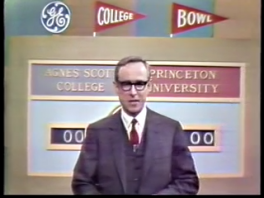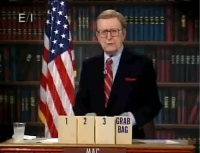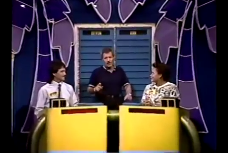


The other night, my wife and daughter and I browsed through YouTube for episodes of old TV game shows.
We saw “Concentration” from 1958 with Hugh Downs as host, and a later 1970s version with Alex Trebek in a polo shirt, not a suit.
Next I tracked down a “To Tell The Truth” from Christmas, 1956, with a panel of Polly Bergen, Mike Wallace, Hildy Parks, and a still-relatively unknown Dick Van Dyke (several years before his sitcom and “Bye Bye Birdie” and “Mary Poppins”), hosted by the bowtie-wearing Bud Collyer. In those days, quiz shows had a single sponsor, which got signs on the stage and live commercials, too. This one was sponsored by a long-forgotten product called Zarumin.
We moved on to a 1974 episode of “Jeopardy,” without the exclamation mark but with much smaller prize values than today. I love the Trebek version, but got a big kick out hearing announcer Don Pardo and host Art Fleming, who always said, “The answer is…” before reading each clue (here’s the story of my mother’s four-day run on “Jeopardy” in those days).
We viewed a 1963 “Password” with host Allen Ludden pretending he had no relationship with celebrity contestant Betty White, who played against Shelley Berman. The proceedings were loose and fun, and my daughter giggled each time announcer Jack Clark whispered, “The password is….” We followed that up with the classic “Odd Couple” episode where Oscar Madison (Jack Klugman) is the celebrity contestant (vs. Betty White, again) with Felix Unger (Tony Randall) as his ridiculous partner. I’m talking about you, Aristophanes!
Then it was on to a show I remember as airing right after “Jeopardy” for a few years in the early 1970s on NBC, “The Who, What, or Where Game,” hosted by Art James, who seemed a bit too formal for the job. He also hosted the New York version of a weekly high school quiz show called “It’s Academic.” Two things which always struck me about “It’s Academic” were that the school’s cheerleaders were there to root for the smart kids at the desks — a nice turn from always cheering for the jocks — and that the bleachers for the audience were never full. The only people who attended the taping were the friends and family of the contestants.
“It’s Academic” was produced separately in different markets around the country, featuring high schools from those areas. The Washington, DC, version holds the Guinness record for longest-running quiz show in TV history. It started in 1961 and was hosted by Mac McGarry for a remarkable fifty years. We watched one of his old episodes, as well as one from this year, hosted by Hillary Howard, now a news anchor at WTOP radio who used to work with my wife at WTTG-TV. She’s fine, but Mac was the personification of the show, making every one of those bright high school kids feel comfortable while keeping the broadcast moving.
Growing up on Long Island, my parents would occasionally take me to tapings of game shows in the NBC studios at 30 Rockefeller Plaza. Most of the time, we just walked up, got free tickets, joined the queue, and were escorted upstairs with the rest of the audience. That’s when I started dreaming of some day working in that art deco palace — which I’m proud to say I accomplished in the mid-1980s.
It was fascinating to see how many crew members it took to make game shows work (e.g. there were no less than three stagehands pulling the cards in the “Jeopardy” board to reveal the answers and Daily Doubles). The one thing they all had in common was that the broadcast professionals behind the podium were experts in easing the anxiety of the contestants, congratulating the winners, and consoling the losers even after the cameras were turned off.
I loved it when we got into “Concentration,” because each audience sat for the taping of three half-hour episodes and Downs was so smooth and likable. The game itself was relatively easy — match hidden prizes and solve a rebus puzzle to win — especially compared to the stumpers Robert Earle asked on “GE College Bowl.” If you think the questions on “Jeopardy” are hard, you won’t believe some of the stuff those undergrads had to come up with on the spot. Lynn Yu just wrote a piece about “College Bowl” for Slate (“The Greatest Upset In Quiz Show History“) that includes embedded video that’s fun to watch and reminded me of a story.
We had gone to see “Concentration,” but its seats were full, so we were steered into the studio for “College Bowl.” I was probably about 10 years old and not happy because, unlike my parents, I had no clue what most of the questions meant, let alone what the answers were. Except for one.
I don’t recall what it was, but I was so excited to know it that I blurted out the answer a little too loudly. People nearby turned towards me in shock as if by breaching the silence I had just condemned a man to death. But the show kept rolling. A minute or two later, during a regularly-scheduled commercial break Earle stepped forward to rather matter-of-factly remind those of us in the bleachers to please not do what I had just done. As I felt guilty and fought back tears (had I just ruined a TV show?), he looked in my direction and joked, “I know how you feel. The only way I’m sure about these answers is they’re on the cards in front of me, but on the rare occasions I know one, I want to shout it out, too!” Then he winked, shrugged his shoulders, and went back to the podium to continue the game. My dad put his arm around me and we went back to watching the show.
Now, here we are 50 years later watching clips on YouTube (shouting out the answers any time we want!) and wondering why some clever TV producer doesn’t bring back “College Bowl,” with or without General Electric. Of course, they’d probably have to put it on Instagram to get that demographic to watch, but at least I’d have a better shot at some of the questions.
